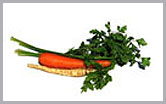 Ranging from leafy vegetables, to edible roots, stems, fruits and seeds vegetables are protective foods used to build and repair the body.
Ranging from leafy vegetables, to edible roots, stems, fruits and seeds vegetables are protective foods used to build and repair the body.
Green leafy vegetables such as spinach, lettuce and other greens are rich in iron, beta-carotene, chlorophyll, and dietary fiber. The darker the colored greens, the more nutritious and the higher the content of beta-carotene.
Key nutrients: Iron, chlorophyll, sulphur, Vitamin A
Benefits
Spinach builds blood, improves complexion and rids the body of toxins. It is a diuretic, and helps relieve constipation.
Key nutrients: Chlorophyll, iron, Vitamin A and C.
Benefits
Lettuce improves the quality of blood, helps detoxify the body and is useful in the treatment of hemorrhoids.
“Fruit” vegetables, such as tomatoes, squashes and peppers, contain ripened seeds of pollinated flowers. These are usually filling and yet low in calories.
Key nutrients: Calcium, phosphorus, iron, Vitamin C
Benefits
Tomato detoxifies the liver, purifies the blood and improves digestion. A rich source of Vitamin A, it helps treat eye problems. It is also helps control blood sugar levels (for diabetics) and reduces weight.
Key nutrients: Calcium, phosphorus, Vitamin C, iron
Benefits
Cucumber is a diuretic, it reduces toxins, purifies the blood and skin. It treats inflammatory conditions, including stomach inflammation, conjunctivitis, acne and inflamed skin.
Flowers, buds and stalks include celery, cauliflower, broccoli and asparagus. These plants are rich in dietary fiber and Vitamin C.
Key nutrients: Vitamins A, B and C, sulphur, silicon, iron
Very high in silicon, celery helps strengthen joints, bones, arteries and all connective tissues. It helps treat rheumatism, arthritis, gout, and nerve inflammations.
Key nutrients: Calcium, phosphorus, magnesium, iron, Vitamins A and C
Benefits
Asparagus contains the diuretic asparagine, which eliminates water through the kidneys. It also helps reduce cholesterol and high blood pressure.
Roots and bulbs are parts of a plant that store nutrients. Vegetables from this group are not generally low in calories, but are mineral –rich and filling.
Key nutrients: Sulphur, phosphorus, calcium, iron, Vitamin C
Benefits
Onion lowers blood pressure and cholesterol; treats dysentery; and is a common cure for respiratory disease. Iron is easily assimilated, and helps treat anemia.
Juice of the raw onion can be used externally to reduce pain and swelling caused by insect bites.
Key nutrients: Vitamin A, sodium, sulphur, chlorine, iodine, calcium
Benefits
Carrots improve vision, skin quality, and strengthen the teeth and gums. They also improve digestion and help purify the blood.
Key nutrients: Iron, potassium, calcium, magnesium.
Benefits
Beetroot helps digestion, reduces constipation and improves functioning of the kidney and gall bladder. The high iron content improves blood quality and reduces hypertension.
Examples are peas, green beans, okra and drumstick. These vegetables contain more protein than other vegetables.
Key nutrients: Calcium, phosphorus, iron, Vitamin C
Benefits
Drumstick strengthens the bones, purifies the blood, and treats asthma and other respiratory diseases. Its antibacterial properties help prevent infection.
- Eat Right
- Know your Veggies, Fruits, Nuts and Herbs
- Eating Right and still being a Vegetarian
- Water Works
- Go the Juicy Way
- Yes- yes and No- No
- Food Facts
- Meal Plans
- Analysis of Fad Diets
- Calorie Counter
- Sprouts
- Food Excuses and how to beat them
- Myths and Misconceptions about Food
- Are you getting Enough Fibre?
- Perfectly balanced Indian Food: An Overview

